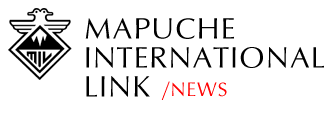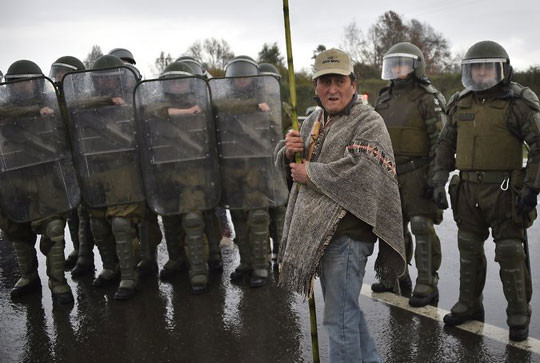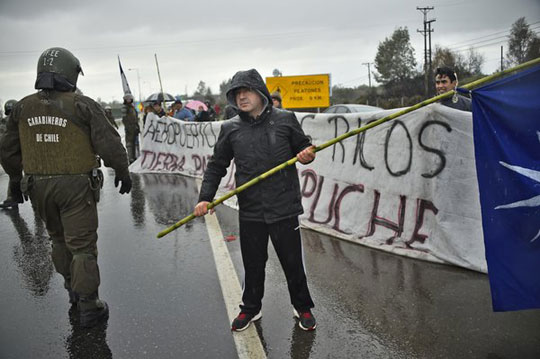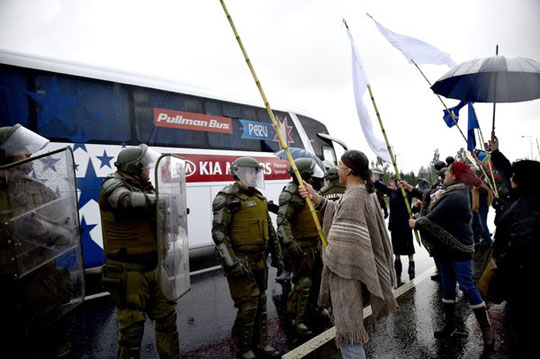



By DAVID WALDSTEIN | JUNE 24, 2015

Mapuche protesters in Chile have attempted to bring their cause to an international audience by demonstrating during the Copa América. Credit Rodrigo Buendia/Agence France-Presse — Getty Images
TEMUCO, Chile — On a cold, rainy afternoon just a few hours before Brazil played Peru in the Copa América last week, four policemen stood guard by a set of flagpoles in the town square here. Days earlier someone had managed to take down one of the red, white and blue Chilean flags and replaced it with the traditional Mapuche flag in a peaceful but poignant protest.
The Mapuche flag, a symbol of Chile’s largest indigenous group, remained aloft for only a short time before it was discovered and replaced with the official flag. Then the guards were posted to protect it.
“See them over there,” Venancio Coñuepan, a Mapuche advocate, said through an interpreter the day of the Brazil-Peru match. “They don’t want to let that happen again.”
Mr. Coñuepan, a 25-year-old law student, said he was not responsible for the flag switch. But he appeared to revel in the nonviolent protest, especially in the timing of it.
Temuco is seen as the capital of the Mapuches, an indigenous people who thrived here long before Europeans began arriving in South America five centuries ago. So the city’s hosting of several matches in this summer’s Copa América — South America’s 99-year-old international soccer championship — has been a chance for advocates to press issues facing Mapuches before an international audience.

Activists say the Mapuche, who are indigenous to Chile, have not been adequately compensated for land used to build an airport. Credit Rodrigo Buendia/Agence France-Presse — Getty Images
Two weeks before Temuco hosted its first game in the Copa América, Ricardo Celis, a member of the City Council, made a formal request to the mayor that the Mapuche flag be raised alongside the Chilean flag in the town square during the tournament.
Mr. Celis, a physician who is not Mapuche, said he made the request to recognize Mapuche influence at a time when the attention of South America would be focused on Chile and Temuco. But his request was rejected by the mayor, Miguel Becker, on the grounds that the national flag already represented all Chileans and that another was unnecessary.
“I feel this is very wrong,” Mr. Celis said in a telephone interview. “If you go to Santiago or Valparaíso and ask people about Temuco, they will say it is the home of the Mapuche people. During the Copa América, it is important to recognize that the Mapuche people live here, too.”
He said that in the days after he made the request on May 19, he saw support for and against it split evenly on social media. The disagreement over the flag reflects some of the larger issues that have pitted Mapuches against some Chileans of European descent, a gap that Mr. Coñuepan seeks to bridge.
A year ago, he founded an organization called Fundación Chile Intercultural to promote the rights of Mapuches and to foster a better understanding about their cause among the general population. The focal point of some of the worst disagreements pits Chilean farmers and lumber companies against Mapuche dissidents over long-disputed land rights, and those conflicts have drawn much publicity.
But there have been other more peaceful Mapuche protests surrounding the Copa América. On June 10, a few days before the flag incident, a group of about 40 Mapuche demonstrators temporarily blocked the road on which the Peruvian team bus was traveling from the Temuco airport, forcing the Peruvian players and officials to wait until the demonstration was dispersed. The activists contend that the airport was built on traditional Mapuche land, for which they have not been adequately compensated.
Many of the fans coming to Temuco for the Copa América travel through that airport. Temuco has already hosted two games in the Copa América, and on Thursday it will be the site of a quarterfinal between Bolivia and Peru.
“This is not to disrupt the Copa América, and it is not directed against the Peruvians or the Chilean people,” Coñuepan said through an interpreter. “It is to highlight the problems we face. The Chilean people think, ‘Oh, the Mapuche want a war, the Mapuche want to burn my house, the Mapuche are bad people.’ But our only problem is with the government, not with the farmer or the people.”
A passionate defender of his people’s civil rights, Mr. Coñuepan is also a devoted soccer fan and supporter of Chile’s national team. He noted with pride that some of its players — like the former striker Marcelo Salas and the current midfielder Jean Beausejour — are Mapuche. He also pointed out that the logo for the 2015 Copa América incorporates aspects of the design of the Mapuche flag, even if organizers and political officials refuse to fly it.
But Mr. Coñuepan also turned and pointed to a large statue near the flagpoles in the central square as fans in the red and white of Peru and the yellow of Brazil paraded by and took photographs with it. The statue was intended to commemorate the centuries-long interaction between the Mapuches and the Spanish and their descendants, but some, like Mr. Coñuepan, find it offensive.

The Peruvian team bus passing Mapuche demonstrators outside the Temuco airport on June 10. Credit Rodrigo Buendia/Agence France-Presse — Getty Images
It depicts a conquistador holding a cross, a noble indigenous woman, a heroic farmer, a calm Chilean soldier with his gun at his side and an almost grotesquely distorted Mapuche warrior brandishing a spear.
“This is racism,” Mr. Coñuepan said.
At times the conflict of cultures has escalated into open hostility, with reports of arson at the farmhouses of Chilean farmers and of police brutality against Mapuches, who are somewhere between 8 and 11 percent of the Chilean population but perhaps almost a third of those in the Araucanía region around Temuco. The widely accepted term Mapuche actually refers to several groups of indigenous peoples in Chile and Argentina.
Some seek rights to confiscated land. Some seek greater political participation, or the expansion of cultural identity, including the Mapuche language, Mapudungun, and in some cases autonomous regions similar to those of indigenous peoples in the United States.
In Chile, some estimate the Mapuches retain only five percent of their traditional land, and they are not recognized in a constitution that has been difficult to amend.
Under the 17-year dictatorship of Augusto Pinochet that began in 1973, the government terminated collective property, which had a devastating effect on the Mapuches. Since then, spotty efforts have been made to address the land issue.
“There are good intentions on behalf of the government,” said Jorge Contesse, a Chilean professor of international law at Rutgers University. “But I would say the results have been inconsistent, at best.”
The Pinochet regime also enacted an antiterrorism law that was later used by the government of the former President Ricardo Lagos, a Socialist, against Mapuche leaders. That resulted in a conviction of the Chilean government by the Inter-American Court of Human Rights in 2014.
“The court’s conviction is a stain for Chile’s democracy,” said Contesse, who served as an expert witness for the court.
Although traditionally of the land, many Mapuche people have moved to urban centers in Santiago and Temuco over the years seeking economic opportunities. José Aylwin, the co-director of the citizen’s watch group Observatorio Ciudadano, said the platform of the Copa América could not be ignored.
“It is quite relevant,” he said. “These games are being played in the heart of Mapuche land.”
Source: The New York Times